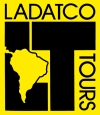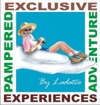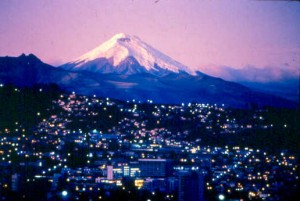

Destinations
Experiences
 |
L A
D A T C O T O U R
S |
 |
||||||||
| HOME | South America | Falkland Islands | Antarctica | Unique Destinations |
Unique Experiences |
Newsstand | ||||
 |
Quito About Quito |
At 9,000 ft. altitude, Quito (pop. 1,100,847) is the second highest capital in South America. Sprawling through a valley running north-south at the foot of Pichincha volcano (14,000 ft), Quito’s setting is spectacular. The old colonial heart of the city is at the foot of Cerro Panecillo, and newer parts of the city are spilling eastwards into two larger valleys.
Quito was designated a World Cultural Heritage Site by UNESCO in 1978. Together with Krakow, Quito was the first city to be honored with such a title.
Quito was originally inhabited by the Caras and the Quitus. By the beginning of the 16th century Quito was ruled by the Incas and was the northern capital of their empire. When the Spanish arrived, the area was razed by a general of Atahualpa to make certain it did not fall into Spanish hands. Thus the colonial city was built on the Inca ruins in 1534 by a lieutenant of Pizarro. The current layout of the old city dates back to the 18th century - cobble-stone streets, parks, plazas and colonial architecture abound.
The heart of the city is Plaza Independencia, dominated by the Cathedral built between 1550-1562. Quito boasts 86 churches. Most notable are the famed La Compania with colored columns, 10-sided altars and high altar plated with gold, and its guilded balconies; La Merced built at the beginning of the 17th century and whose monastery has the city’s oldest clock built in 1817 in London; San Francisco, Quito’s largest church and thought to be the first religious building constructed inSouth America.
There are excellent museums including the impressive Museum Arqueologico with a series of halls with exhibits covering the successive cultures from BC 4000 to AD 1534 with extensive collections of pre-colombian ceramics and gold artefacts. The Museo Guayasamin in Bellavista surburb, has the artist’s works plus a precolombian and colonial collection; works of art and modern jewelry made by the artist can be purchased.
Avenida Amazonas is a popular street lined with shops filled to overflowing with the typical handicrafts of Ecuador - toucans and macaw carvings of lightweight balsa wood, plates and other items of local woods, balsa wood boxes, silver of all types, hand-painted tiles, hand-woven rugs and a variety of antiques dating back to the colonial days. There are also buttons, toys and other things fashined from tagua nuts, ponchos, ruanas and sweaters of all kinds. Fine shops specializing in artisan crafts and antiques abound - one of the popular is FOLKLORE, the ste of the late Olga Fisch who put a designer touch on the traditional.
There are many restaurants of all kinds, including several that specialize in local Ecuadorian foods and folkloric shows - ask at your hotel for the best of the day.